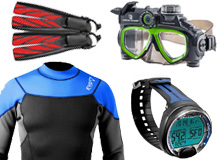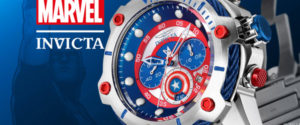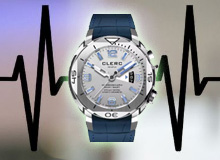 If you decided to start scuba diving, you need to know more about the equipment that is being used under the water.
If you decided to start scuba diving, you need to know more about the equipment that is being used under the water.
If you are living at the sea-side you probably may get the necessary equipment from local sports stores.
However, if you want to have a bigger variety to choose from, you have Internet at your disposal as the main source for researching and purchasing.
If you are new to scuba diving, you must read everything you need to know about scuba diving.
So, if you are wondering which are the most vital and important equipment you need for scuba diving, here is the list of some of the important equipment for you before you go for a dive.
Note some of the listed equipment are necessary while few are optional or required for a specific purpose of your dive.
- Mask – it is considered to be one of the most important items for divers. You explore the underwater world with your eyes and a mask that allows you to see the great marine life is a must. It needs to fit you perfectly to avoid any water getting in your eyes. The price of a mask can start from 10$ and reach hundreds depending on the brand, model, style, quality, etc.
- Fins – the fins that are designed especially for scuba diving help you move more easily and with less effort taken. Do not mix them with fins designed for free diving, body surfing or anything else, as those type of fins will make your diving less pleasant. The standard fins can cost you around 30-40$, but if you are looking for high quality, you will have to increase your budget at least twice.
- BCD (Buoyancy Control Device) – this is one of the components of your equipment that allows you controlling your body. There are different styles of BCDs; like jacket style (the most common), traveling BCDs (they are comparatively lighter), special ones designed for women, etc. The price for similar device starts from around 200$ and goes up to hundreds.
- Snorkel – this is the most personal item of your equipment. It allows you breathing when you enjoy the diving process. Make sure that its mouthpiece is very comfortable and fits you perfectly. Test it for a while before you dive. If it has a self-draining valve, it will assist in cleaning the water from the snorkel.
- Scuba Gear – it allows you to move comfortably, explore the world around you without any inconvenience. Based on your height, weight, duration of your dive you need to find the best fit. Scuba gears will not cost you too much compared to many other scuba diving equipment.
- Regulator – the scuba regulator brings air from scuba tank when you need to breathe. It is the link between several parts of your equipment – tank to BCD, SPG (submersible pressure gauge), air and you. In the beginning you might feel discomfort wearing it, but soon you will get adapted and will not even notice it.
- SPG – it shows the amount of remaining air in your tank. There are some SPGs that are built in the diving computers, some others are mechanical and come as a separate part that you need to use when diving. It will help you finish your dive before your get very short of air.
- Dive computer – if you are a professional diver using dive computer is very important. It gives you an insight on how much time you can stay safely under the water. Mainly it combines the SPG, timer, depth gauge and few other components (it depends on the type of dive computer you use). Dive computers mainly cost a few hundred dollars. If you are ready to go with an older version, you will spend very little amount of money, but if you go with super new computers, you have to pay a pretty high price.
- Dive watch – it is considered as an essential version of dive computers. It allows the diver to keep track of the time left for diving. Dive watches vary depending on the level of water resistance. An up-to-date watch can cost you a lot. The price of a dive watch can reach 2-3000$ and even higher. You can find some budget watches on the web, but keep in mind that the water resistance level might be low (make sure it meets your requirements).
- Suites – there are three main types of suits – a dry suit, wet-suit and body suit. Choice of the suit depends on the water temperature, season, location, etc. As you can face many natural (and not only) objects that can sting, cut or do any other damage, you need to choose your suit accurately, based on the region. The prices of suites also vary. During sales you can get a suit for some 40-50$, but if you look for something really good, you will spend several hundreds of dollars on this piece of diving equipment.
- Knife – the dice knife is generally not used as a weapon, but more to cut entangling fishing line of the tank. It is used to get the attention of fellow divers in certain cases. This is probably one of the cheapest equipment you can get for diving – a nice knife will cost you around 10$.
- Lights – some divers prefer to dive at night or they might reach the parts of the sea/ocean where the lack of light becomes a major issue. This is when the dive lights are used by divers. They come up in different forms, so that each diver can find a type that meets his/ her requirements. This is also a pretty affordable part of your equipment. If you are not looking for something extraordinary you can get a light for up to 20$ on the web.
- Technical Equipment – when you want to go beyond simple diving you will most probably use special technical equipment that includes twin cylinders or closed-circuit re-breathers, plus an additional tank. The price for this equipment varies a lot, and you will have to do some research to find the best combination of price and quality.
- Dive Flag – you can use one to indicate that there is a diver in the area. This is very useful especially if you dive in a more or less crowded part. You can get one for some 10-20$.
- Signaling devices – these are not used very often, but to ensure your safety, it is better to have at least one (it is more reasonable to have 2 devices – audible and visual) signaling device that you can you use in case of emergency. Make your choice wisely. It might be useful to spend some additional money on signaling device.
There are dozens of other scuba diving equipment that you can get and use. This is the general list of equipment that you, as a recreational, technical, commercial or military diver, must own.
Depending on you “mission” under the sea you will have to adjust this list to ensure that you have all the necessary dive equipment with you and that you are following all the safety rules.




Be First to Comment